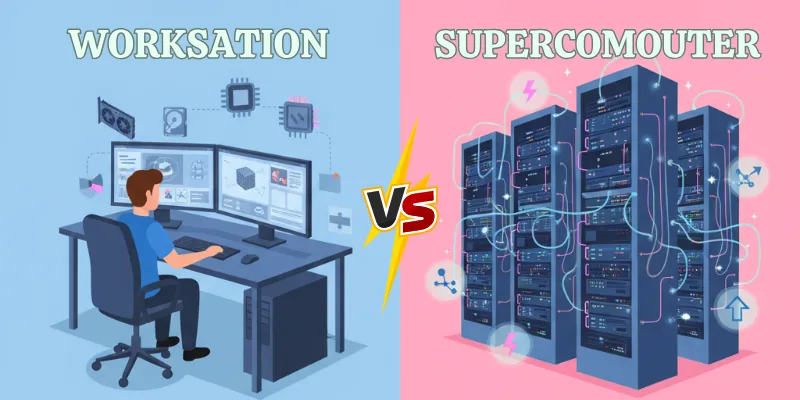Workstation vs Supercomputer: Explained in a Simple and Fun Way
Published: 15 May 2025
Computers are used everywhere. But not every computer is the same. There are two special types of computers: Workstation and Supercomputer. Both are powerful, but their jobs and usage are very different.

In this article, we will explain in easy language what a Workstation and a Supercomputer are, what makes them different, and which one is better for different tasks.
Quick Comparison Table: Workstation vs Supercomputer
Here is a quick comparison table of Supercomputer vs Workstation Computer:
| Feature | Workstation | Supercomputer |
| Speed | High | Ultra High |
| User Type | Single User | Multi User / Institutions |
| Use Case | Design, Editing, Engineering | Research, Space, Weather |
| Size | Desktop Size | Room/Building Size |
| Cost | Moderate | Very Expensive |
| Power Consumption | Moderate | Extremely High |
| Maintenance | Easy | Difficult |
Differences between Workstation and Supercomputer
Let’s talk about differences between Supercomputer and Workstation Computer in detail:
1. What is a Workstation?
A workstation is a powerful computer that can do complex tasks.
Workstation:
- Faster and stronger than a normal computer
- Used for tasks like designing, editing, and simulations
- Has a strong processor, RAM, and graphics card
- Ideal for engineers, architects, and developers
- Made for one user but can do many tasks
- Usually looks like a desktop computer
Supercomputer:
- Thousands of times faster than a workstation
- Used for weather forecasting, nuclear research, etc.
- Has thousands of CPUs working together
- Needs a lot of space and cooling
- Works with large-scale scientific data
- Built to be used by many people or teams
Workstations are for daily advanced tasks, while supercomputers are used for national or scientific-level work.
2. What is a Supercomputer?
A supercomputer is one of the most powerful and fastest computers in the world.
Workstation:
- Can handle demanding software like AutoCAD and Adobe Premiere
- Suitable for heavy multitasking
- Used in small businesses and offices
- Less expensive and compact
- Doesn’t need high-level setup
- Built for personal or business use
Supercomputer:
- Works on complex problems like space exploration
- Used in medicine, defense, and scientific labs
- Performs trillions of calculations per second
- Takes up a whole room or building
- Needs trained experts to run and manage
- Very costly and energy-hungry
Supercomputers are like computer giants made for solving the world’s toughest problems.
3. Difference in Speed
Both computers are powerful, but their speed is very different.
Workstation:
- Very fast compared to normal PCs
- Can run heavy software without lag
- Good for 3D modeling and rendering
- Can run simulations in real-time
- Has high clock-speed CPUs
- Supports multi-threading for fast operations
Supercomputer:
- Fastest machines in the world
- Solves problems in seconds that would take years
- Speed measured in FLOPS (Floating Point Operations per Second)
- Can process big data in real-time
- Thousands of tasks run at once
- Designed for unmatched parallel processing
In terms of speed, Supercomputers are far ahead.
4. Difference in Usage (Use Cases)
Each computer has its own job. The usage of Workstation and Supercomputer is totally different.
Workstation:
- Used in engineering and architectural design
- Ideal for video editing and 3D animation
- Supports software development and testing
- Used in small-scale simulations
- Helpful for financial analysis
- Common in schools, universities, and offices
Supercomputer:
- Predicts natural disasters like earthquakes
- Studies climate and weather patterns
- Simulates space missions
- Used in defense and cryptography
- Helps in genetics and medical research
- Solved scientific problems with massive data
They are used based on the power they offer.
5. Difference in Cost
When it comes to money, there is a huge difference between the two.
Workstation:
- Costs more than regular computers
- Price ranges from $1,000 to $10,000
- Affordable for professionals and small companies
- Has lower running costs
- Easier to upgrade or replace
- Maintenance is simple and low-cost
Supercomputer:
- Costs millions of dollars
- Funded by governments or large organizations
- Expensive to build and maintain
- Needs a dedicated environment and staff
- High electricity and cooling cost
- Can’t be upgraded easily like a workstation
Workstations are more budget-friendly for individuals.
6. Difference in Size and Space
Their size also matches the work they do.
Workstation:
- Fits easily on a desk or under it
- Portable and lightweight compared to a server
- Compact size and easy setup
- Doesn’t need a dedicated room
- Can be moved when needed
- Takes less storage space
Supercomputer:
- As big as a room or building
- Needs special cooling rooms
- Installed in high-security labs
- Cannot be moved easily
- Comes with several connected units
- Requires space for maintenance staff and wires
In size, Workstations are smaller and easier to manage.
7. Power Consumption
Both computers use power differently.
Workstation:
- Runs on regular office electricity
- Power efficient for its performance
- Doesn’t need industrial cooling
- Normal UPS or battery backup is enough
- Suitable for daily long usage
- Green-friendly options available
Supercomputer:
- Needs high-voltage electricity supply
- Produces a lot of heat
- Uses industrial-grade air conditioning
- Needs backup generators
- High monthly energy bills
- Not suitable for casual use
In terms of power, Workstations are more economical.
8. Maintenance and Setup
The way to set up and maintain these systems is also different.
Workstation:
- Easy to install and run
- Can be repaired by local IT staff
- Regular updates and antivirus are enough
- Spare parts are easily available
- Does not need special training to use
- Setup time is minimal
Supercomputer:
- Setup takes months of planning
- Needs a team of engineers and technicians
- Expensive and complex to maintain
- Parts and updates are specialized
- Constant monitoring is required
- Comes with advanced software and controls
For maintenance, Workstations are easier and user-friendly.
Which is Better?
This is an important question, but the answer is simple: the best computer is the one that fits your needs.
- If you’re a designer, engineer, or content creator, then a Workstation is perfect for you
- If you work in a research institute and need to process large data, then a Supercomputer is necessary
- Workstations are great for small teams
- Supercomputers are for large organizations only
- Workstations are cheaper, easier to maintain
- Supercomputers give unmatched speed and power
So both are useful in their own way—it depends on what you need them for.
Conclusion
We hope you now understand the difference between Workstation vs Supercomputer in a simple way. Both are powerful computers, but their roles and uses are completely different. Workstations are for professionals, while Supercomputers are for large-scale science and research.
When choosing a computer for a project, always think carefully about whether you need speed, power, or a budget-friendly option. Each system has its own value.
If you found this article helpful, don’t forget to share it and spread the knowledge!
FAQs about Workstation and Supercomputer
Here are some of the most Frequently Asked Questions related to Workstation and Supercomputer:
A workstation is used for professional tasks like graphic design, 3D modeling, software development, and video editing.
Supercomputers are used in scientific research, space studies, climate modeling, and big data processing.
Yes, a workstation is much more powerful and can handle complex tasks that a regular PC cannot.
Yes, but it’s more suited for professional work. Gaming PCs are often better optimized for games.
A supercomputer can cost millions of dollars, depending on its size and computing power.
Organizations like NASA, research labs, governments, and large universities use supercomputers.
Workstations are bigger than laptops but still small enough to fit on a desk, so they are not fully portable.
Yes, they require cooled rooms, strong electricity supplies, and a team of professionals to manage them.
Not directly. Supercomputers are accessed through special software and shared among many users.
Workstations are more energy-efficient and can run on normal electricity, while supercomputers consume a lot of power.

- Be Respectful
- Stay Relevant
- Stay Positive
- True Feedback
- Encourage Discussion
- Avoid Spamming
- No Fake News
- Don't Copy-Paste
- No Personal Attacks

- Be Respectful
- Stay Relevant
- Stay Positive
- True Feedback
- Encourage Discussion
- Avoid Spamming
- No Fake News
- Don't Copy-Paste
- No Personal Attacks





